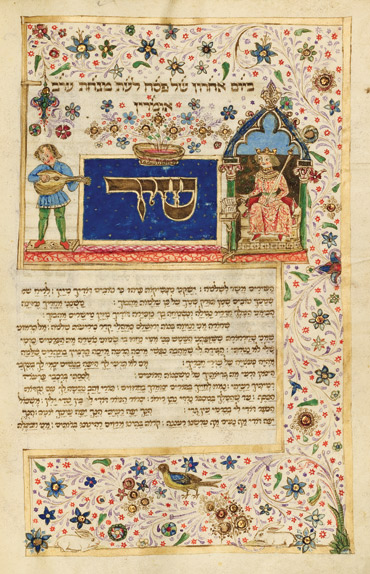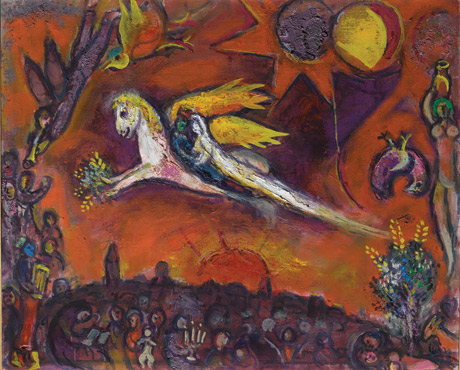I Have Come to My Garden
A 10th-century midrash says in the name of Rabbi Akiva: “Had Torah not been given, it would have been possible to conduct the world on the basis of the Song of Songs alone.”
What a world! What a religion! Instead of reams of law, narrative, ethical discussions, ritual taboos, sacred times, food proscriptions, and the rest of Torah, all we would have is a collection of erotically charged love poems: “Ah, you are fair, my darling, / Ah you are fair. /Your eyes are like doves” and “Come, my beloved, / Let us go into the open; /
. . . There I will give my love to you.” How, precisely, might we “conduct the world” with such verses? For Akiva—or those who spoke in his name—the answer was quite obvious. This is the same Rabbi Akiva (putting the question of attribution aside again) who said that “all of Scripture is holy, but the Song of Songs is the Holy of Holies.”

According to Akiva the Song of Songs was originally spoken by God, the people Israel, and the chorus of angels at Sinai itself. It was only written down later by King Solomon (“The Song of Songs by Solomon,” says the superscription). As the God of exoteric Judaism was giving Israel the Torah, the same God-as-secret-lover was whispering these poems into His beloved’s ear. Inner and outer teachings thus fully correspond to one another. Without the exoteric Torah, we would be able to discover all its truths by delving deeply into the words of the great canticle. All you need to know, so to speak, lies hidden within this song.
Jews believed one version or another of these claims about the Song of Songs for many centuries. The early rabbis denounced anyone who used its holy words as mere tavern-songs. The great commentators of the Middle Ages, including even such a sharp-eyed rationalist as Abraham ibn Ezra, were reluctant to offer literal readings of the text that would have it “merely” refer to the courtship of a shepherd and shepherdess amid the Judean hillsides. The Zohar, the greatest work of Jewish mysticism, is written under the intoxicating spell of the Song’s perfumed gardens. Hardly a page in that work goes by without a reference to one or another of its verses or symbols derived from it. Pious Sephardi and Hasidic Jews chant it every Friday evening, often coming to know it by heart. Its allegorical reading inspired the famous Sabbath hymn Lekha Dodi and the construction of Shabbat as a feast of divine and marital love. Only in the mid-19th century, under the influence of modern scholarship, was the simple meaning of the text relegitimized, part of an emerging land-centered romanticism in which echoes of the Song of Songs came to course through the lyrics of both highbrow Hebrew poetry and popular Israeli music.
The hidden meanings of the Song of Songs were then largely forgotten, relegated to the eyes of scholars alone. English readers certainly had no access to them; even in Hebrew and Aramaic they were locked away. Many of the key Hebrew commentaries remained in manuscript until recent years. An English reader who wanted to taste the traditions of erotic piety inspired by the Song of Songs would have to go to one of the many Christian commentaries, ranging from Origen to Bernard of Clairvaux to Teresa of Ávila and beyond, mostly available in English translations.
Now that situation has been dramatically transformed. Michael Fishbane has written a daring and innovative commentary on the Song of Songs in The JPS Bible Commentary series. Following the medieval fourfold theory of interpretation, he interprets each verse in the Song on the peshat (literal), drash (homiletical, rabbinic), remez (philosophical, personal quest), and sod (mystical-esoteric) levels. Let the newness of this approach sink in. This is the first attempt ever to compose such a commentary in English and the first new Jewish attempt at such consistent multi-leveled interpretive writing in several hundred years. (It most calls to mind Rabbi Bahya ben Asher’s commentary to the Torah, written in Barcelona in about 1300.) Fishbane is offering us a chance to recover the richness of reading scripture in multiple dimensions that was stripped away by the modern insistence, beginning with Spinoza, that only a critical and contextual understanding of scripture was truly legitimate. Postmodernity has now come along and upended that modern arrogance. Only in that context is a commentary like Fishbane’s again possible. It is a work of innovation and restoration at once.
Michael Fishbane is a unique phenomenon in the world of contemporary Jewish scholarship. When he and I were fellow doctoral students, and then Havurat Shalom instructors, 50 years ago, he was a budding Bible scholar while I was a student of the mystical tradition and Hasidism. But over the course of the last five decades, Fishbane has made a remarkable trek across the full range of classical Jewish literature, going from Hebrew Bible to midrash, on to Zohar and medieval Kabbalah, and thence to the writings of the Hasidic masters, ever expanding both his scholarly repertoire and his personal spiritual embrace of the sources and their ways of reading scripture. His Sacred Attunement: A Jewish Theology, published in 2008, marks him clearly as a theologian of the first rank as well as a distinguished scholar.
Fishbane’s journey has been carried out on the wings of his sustained faith in the multivocality of the tradition, a theme he has discussed for many decades and one that underlies Sacred Attunement. But here he has actually carried it out. He begins with a fine philologically based peshat commentary, replete with the expected references to ancient Near Eastern parallels to the Song of Songs. Here he stands in the tradition of such other modern Jewish Bible commentators as Robert Gordis and Yair Zakovich. He then goes on, verse by verse, to offer an insightful summary of the rabbinic drash, where the Song is read as a national allegory of the love of God and Israel through history, but focused especially on the sacred narrative of Exodus and Sinai.
What is really new and exciting here, however, comes in the next two levels of commentary, where the allegory turns toward the religious life and inner journey of the individual seeker or devotee. Here Fishbane offers nothing less than a strikingly revealing and accessible exposition of his own religious quest, presented in dialogue with this text that he knows and loves so well. Yes, to be sure the remez and sod passages are studded with references to the various Ibns and others of medieval Jewish commentary, but make no mistake, Fishbane is leading us into the ongoing voyage of his own soul.
Examples could be taken from almost anywhere in this rich commentary. I will choose two from the fourth and fifth chapters, where the lovers’ passion attains some of its greatest heights. Remember that in the remez and sod portions of the commentary, the male “Beloved” of the canticle is God and the bride is the human seeker:
You have captured my heart . . . (4:9)
Remez: The Beloved goes beyond descriptive praise (vv. 1–7) and solicitation (v. 8), and now expresses the total effect of the seeker upon him. He confesses that “my heart” is no longer my own, for you have “captured” it. This is more than physical capture. The verb libbavtini suggests that the seeker’s love has magnified the Beloved’s own heart (leibh)—doubled it (so to speak) by its inclusion in his own. Perhaps the Beloved conveys something of the mysterious magnification of love that occurs when there is spiritual mutuality. And perhaps when one partner is a human soul, the love that throbs in its heart enhances the qualities of love in the depths of Divinity, so that this enhancement returns to the soul and confirms it reciprocally . . . This is love requited at the deepest level.
The gift of human love, Fishbane is telling us, stirs love within the divine Beloved, making the relationship a fully mutual one. Maimonides would shudder at the bold anthropopathism here, but Rosenzweig and Heschel, not to speak of Ezra of Gerona, would recognize echoes of their own theological voices.
I have come to my garden . . . (5:1)
Sod: The Beloved responds. There is now a divine advent to the garden—a figure redolent with nuance. It is both the inner space of spiritual cultivation—the soul, and the outer space of divine creation—the world. The Beloved comes to the soul through the world and its bounty, perceived in its God-rich splendor. Divine immanence births our spiritual consciousness. All is seen and felt anew; all is replete with godly beneficence . . . The world is reborn for the awakened soul; the gifts of God are the munificence that enlivens all Being with potential.
Here we see what may be a bit of 21st-century consciousness peeking through Fishbane’s remarkably rich classical language. It is appreciation of the outer “garden” of the natural world that stirs us to cultivate the spiritual garden within in this comment. Although the allegory of the canticle requires dialogue and thus seems addressed to a transcendent Other, it is immanence, meaning the presence of that Other within creation, that sets us on our path.
The heart of chapter five (5:10–16) is the bride’s fully detailed and unabashedly erotic description of her lover’s body. This is a moment where the heterosexual male reader is potentially taken aback. Having entered into the poesis of the allegory, he has tacitly accepted his self-identification as the bride of the cosmic Beloved. But here he suddenly finds himself waxing eloquent over the belly, thighs, and legs of that Beloved. This can easily be too much, and it is perhaps for this reason that Fishbane here decides to step back and tell us how far he stands, theologically, from literal anthropomorphism:
Sod: 10–16. To imagine the divine reality in the form of a person is to envision the spiritual dimension through the figure of a human body: a supernal projection of mind, height, and extension—but also of value, character, and action. To configure the Divine in human terms is to “shape” absolute being with vitality, purpose, and foundation; and to bless personhood and accord it a divine-like dimension. To be sure, personhood is not the only imaginable form that may be ascribed to Divinity. Nonetheless, it is one of the most meaningful ways that humans experience God in relation to human life and its purposes. Thus if theopoetic boldness dares humanize the transhuman, it conveys infinite value to human life and action.
As anyone in any tradition engaged in a long-term relationship with God knows, life has its high and low points, moments of elation and truth alternating with those of emptiness and abandonment. The rhetoric of the Song of Songs is well suited to this rhythm. The bride longs for her lover and searches through the empty streets and marketplaces. The verses of the Song describe a love that is never quite consummated, coming close to such fulfillment only in rare moments. As they used to say about romance in the old Yiddish theater: “When he wants, she doesn’t want; when she wants, he doesn’t want, and when they both want, down comes the curtain!” Paradoxically, it may be this quality that made the Song of Songs work so well as spiritual allegory, hence preserving it through the ages.
Fishbane’s commentary is supported by a lengthy introduction and an especially rich excursus on the history of Jewish Song of Songs interpretation. He has waded through several genres of extraordinarily difficult and obscure commentary, including both the Aristotelian and the kabbalistic. His ability to rescue textual insights from the theoretical frameworks in which they were presented (and often trapped) is truly remarkable. But it is only his willingness to use his own sensibilities as a seeker that allows him to offer these readings in a way that gives them dramatic new life.
If anything is lacking in this magnificent undertaking, it is Fishbane’s apparent lack of engagement with the very rich traditions of Christian interpretation of the Song. In fact, the Jews were rather latecomers to the whole notion of applying the Song of Songs to the spiritual life of the individual. Our early rabbinic sources were fully engaged by the national allegory at a time when Origen was already reading the text as a guide to one’s personal religious quest. For Jews that came about only a millennium later, with Maimonides. Of course Fishbane’s volume is large enough that he may not have felt there was room for this discussion. But I feel its lack because I suspect that his own reading is more influenced by those Christian interpretations than he lets on. Bernard of Clairvaux and others often provide deeply personal, even intimate, readings of the canticle, in ways that seem to grow directly out of the celibate innocence of monastic spirituality. Fishbane remarkably finds—or is he creating?—a similar approach to the text from within the Jewish sources, but to reach it he has to strip away layers of philosophical or kabbalistic theory.
Perhaps it is just that Fishbane’s commentary is in English rather than Hebrew that constantly (and happily) reminds me of the spiritual readings going on “across the street” in the local Western European abbey (or perhaps not).
Suggested Reading
Minyan 2.0
The next big thing in prayer.
The Man Who Thought in Pictures
S.Y. Agnon was a completely visual thinker. Now his stories have been turned into a comic book.

My Father and Birnbaum’s Heavenly City
According to one scholar, Uriel Birnbaum produced “more than 6,000 poems, 130 essays, 30 plays, 10 short stories, 15 fairy tales, fragments of a longer epic poem, 20 chapters of a lost novel and 30 collections of illustrations.” And yet, Birnbaum received little acclaim in his lifetime. Today he is all but unknown.
The Limits of Prayer
One who prays to change the past, says the Mishnah, “utters a vain prayer.” A person should not beseech God to undo events that have already taken place, even when the outcome is still unknown. And yet there are circumstances where one is naturally tempted to do just that.

Comments
You must log in to comment Log In